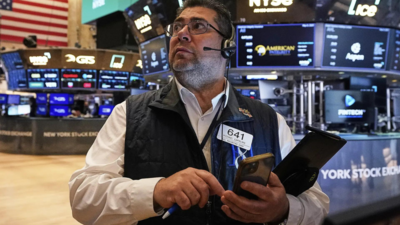US stock markets opened with significant losses on Friday following renewed trade tensions triggered by fresh tariff threats from President Donald Trump. In a series of posts on Truth Social, Trump called for a 50 per cent tariff on European Union goods starting June 1 and threatened to impose a 25 per cent tariff on Apple products unless the company relocates iPhone manufacturing to the United States.These announcements rattled investor confidence, sending major indices deep into the red at the open.The Dow Jones Industrial Average fell 436 points or 1.04 per cent to 41,423.04, while the S&P 500 declined 67 points or 1.15 per cent to 5,774.90 during initial minutes of trading. The tech-heavy Nasdaq dropped the most, losing 300 points or 1.59 per cent to 18,625.56. Market volatility spiked, with the CBOE Volatility Index (VIX) surging 18.54 per cent to 24.04, indicating heightened investor anxiety.Apple shares slid 3.8 per cent in early trading following Trump’s comments, reflecting concerns about potential cost increases and supply chain disruptions. Other companies also took a hit, including Ross Stores, which plummeted 13 per cent after issuing weaker-than-expected guidance, and Deckers Brands, down 19 per cent despite strong quarterly results, as both cited growing economic uncertainty linked to trade policy.Earlier, Futures markets had already signalled a rough open after Trump, in a post on Truth Social, demanded a “straight 50 per cent tariff” on the European Union starting June 1, citing stalled negotiations. He also threatened a 25 per cent tariff on Apple products unless the company shifted iPhone manufacturing to the US sending Apple shares tumbling by 3.8 per cent in morning trading.In response to the trade threats, European markets moved sharply lower. Germany’s DAX fell 1.9 per cent, France’s CAC 40 dropped 2.4 per cent, and the UK’s FTSE 100 lost 1.1 per cent. Investors across the continent reacted quickly to the possibility of renewed transatlantic trade friction. The global market downturn reflects growing concern over the potential for tariffs to derail economic recovery and corporate profitability.Meanwhile, commodity markets showed divergent moves. Gold rallied 1.73 per cent to $3,352 per ounce as investors sought safe-haven assets amid the uncertainty. Conversely, oil prices extended their decline for a fourth straight session, with US benchmark crude falling 1.06 per cent to $60.55 per barrel, pressured by concerns over global demand and potential disruptions to international trade flows.Bond markets also reflected the shift to safety, with US Treasury yields dropping. The 10-year yield fell to 4.497 per cent, down 5.6 basis points. Yields had climbed earlier in the week after the House of Representatives passed a multi-trillion-dollar tax package, raising fresh concerns about federal debt levels. The bill is expected to face changes in the Senate.Asian markets closed mixed ahead of the US open. Japan’s Nikkei 225 rose 0.5 per cent following a report that core inflation reached 3.5 per cent in April, the highest since early 2023, prompting speculation of a possible interest rate hike by the Bank of Japan. However, the Shanghai Composite fell 0.9 per cent, and South Korea’s Kospi slipped 0.1 per cent, reflecting broader regional caution amid ongoing global uncertainty.












